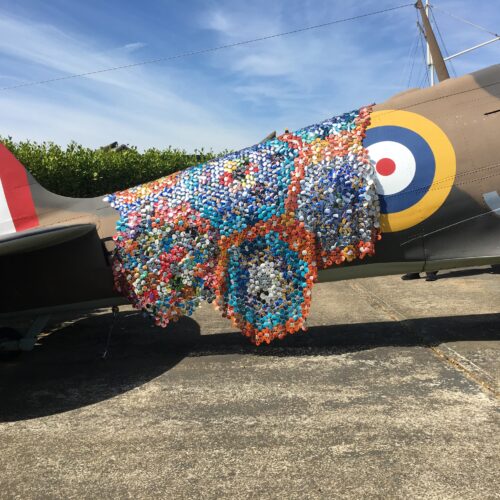
Light and Line in Barnsley

Pat Hodson led a recent study visit in Barnsley and reports for us here: ‘In retrospect, this exhibition was perfect for a study visit. The gallery is compact, but modern, light and quiet. We were the only visitors, so could discuss and debate the work freely. The exhibition was small, but in featuring only two artists, it allowed us to look closely at each group of work and to see where the connections and differences between the two artists lay. Both have fine art backgrounds, and both have found something in the tactile quality of cloth that they wanted to explore – and have done so for most of their working lives. The result is a mature vision and confidence with visual language.
As in any public gallery, you can’t touch, and fabric cries out to be touched, so you often have to imagine the sense of touch from what you see, so it was a bonus when we were provided with several samples of cloth to handle, which allowed us to begin to understand how the surfaces of Anne Morell’s work was formed. Both artists use stitch as mark and line but to both the surface of the cloth is significant. They both abstract out marks, lines and patterns from the environment, but with very different results.
Anne Morrell tensions her cloth over a stretcher, then floats it within a frame. This creates a greater contrast between the puckers and creased areas, caused by her particular technique of stitching from the back and the smooth flat areas. For me this accentuates an illusion of texture, space and plane. Artists use the technique of placing small marks massed together in a drawing to suggest an illusion of texture. Anne’s stitches create a deep puckering of the surface so the illusory and the actual seem to fuse together. Likewise, her lines of stitch suggest a plane, a surface, but are ephemeral, like sunbeams, or shadows.
Polly Binns, on the other hand, lets her hangings drop freely from nails with edges unfinished. They move slightly as you pass. The surface undulates and has unexpected light and shadows – which lessens the illusory and increases the reality of the cloth in front of you. You see the stitch for its own sake. Occasionally she reinforces a crease to create a strong textural line which throws deeper shadows. Although the marks suggest things you see on sand and marsh, the canvas is so honestly hung that you are continually brought back to its material reality. Her palette is confined to a very limited narrow tonal range which suggests English light near the sea. Anne Morrell’s colours are very different and suggest a light which is more burning, shadows stronger, but it is coloured light, colours of darkness. Another interesting illusion she uses is to draw parallel lines of stitch, which pass over and sometimes through the light and shadows – lines of light become surface plane.

Both artists observe their environment in minute detail, yet neither use representation. Anne Morell likes to create a sense of being in a landscape – ‘suggesting rather than stating” about the light and shadows around her; her garden pond – making her aware of surface tension. For Polly Binns, it is the act of walking the landscape as Richard Long does, and observing the minute and continual changes in the land, sea and light and drawing – catching ‘ a half glimpse’ through drawing – however brief, rather than working from photographs. This last made us all think and became a very interesting talking point later. The ease at which we can record by taking photographs as apposed to scribbling and jotting visual notes in the discomfort of a cold winter’s day, then trying to make sense of them later.’
This exhibition is on until January, then travels to the Turnpike Gallery, Leigh in greater Manchester and finally back to the Castle Museum in Nottingham. I suggest that it would be of interest not only to those on a textile route, but for anyone who is interested in how artists develop their own particular voice and techniques in interpreting and suggesting visual phenomena.






It was a very worthwhile study visit not least because the shared discussion and viewpoints gave one a much greater insight that would have been more difficult to achieve alone.
I hadn’t been to Barnsley Civic before and it was a wonderful surprise! The staff were very friendly and helpful, and we had the gallery to ourselves!
It was interesting to see the similarities and differences in the work. In the later work, they seemed to come closer together, both paring back to the minimum, and both capturing the felt experience of fleeting movements of light and water.
I would like to have seen some photos of the work up close. I like the fact that you were allowed to handle samples of fabric- so important for tactile work. I also like what was said about recording through sketches, no matter how fleeting, and how this translates into the pieces which, by the sound of it, are stitched drawings.
You share the words but not the photos. Photos of the people who take part are no help for all of us who cannot take part in the Study Visit. I can google the names and maybe get pictures so thanks for that
I have photos from the exhibition. I’ve started writing up my blog post on the study visit and should be able to publish by Wednesday this week. Will make sure I put on some close ups for you
Close ups for you Edith & Olivia! http://lizzyslearningblog.blogspot.co.uk/2013/01/oca-textiles-study-visit-light-and-line.html
Thanks Lizzy for your learning blog on ‘Light and Line’ – inspired me to get to the Turnpike Gallery – bit more accessible.